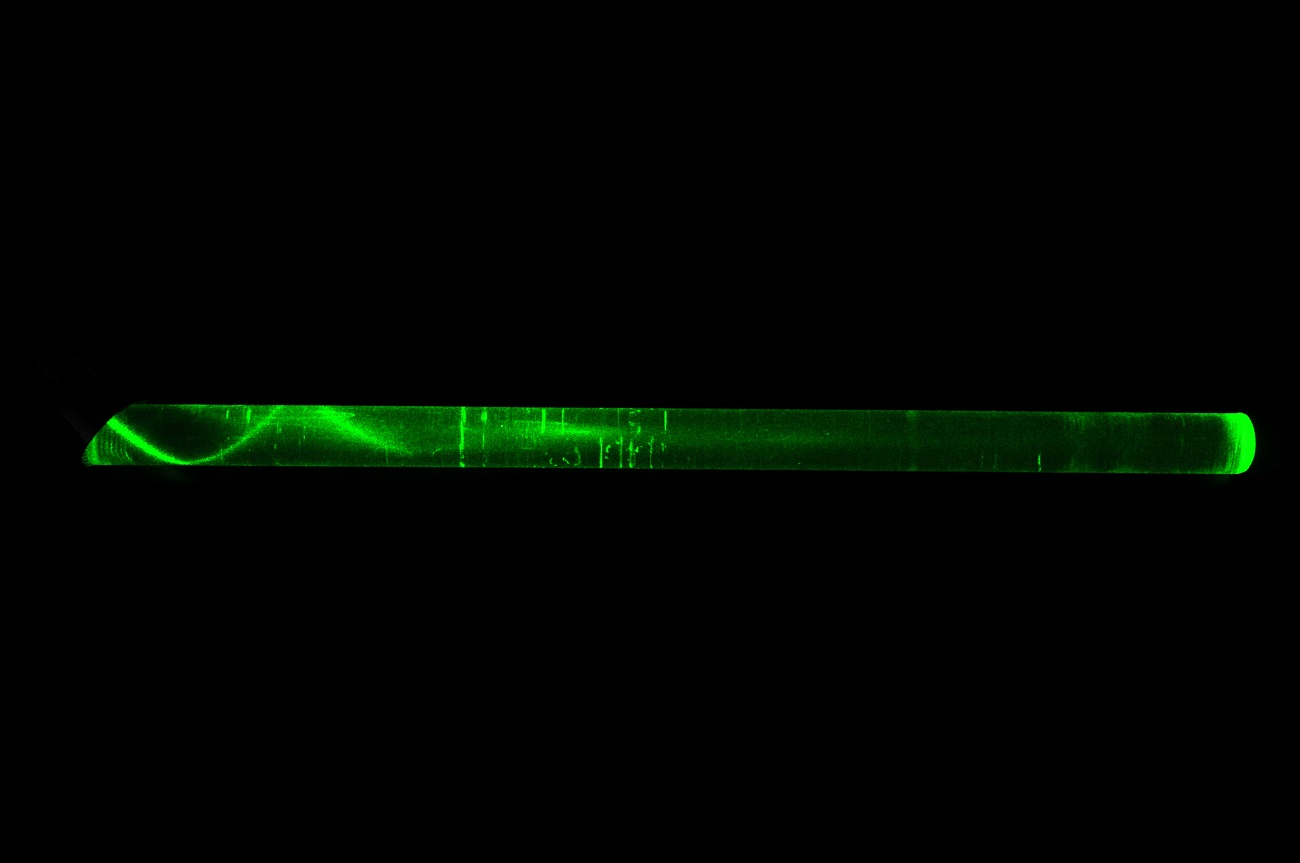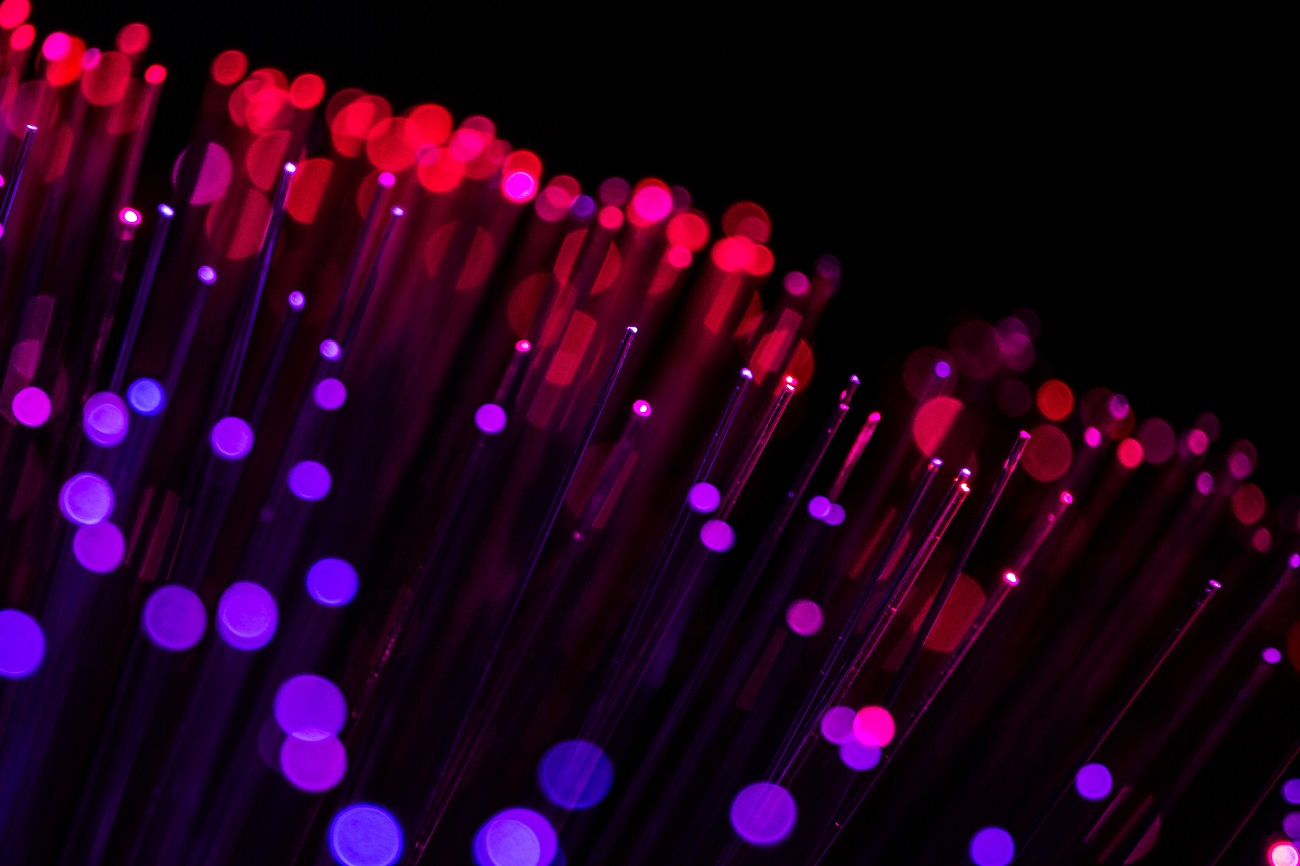Engineers "twisted" the light in the fiber - a new technology will speed up the transfer of data a hundred times
In October, Nature Communications magazine published a scientific paper by engineers from Australia, which described the technology of data transmission using "twisted into a spiral" light.
Under a cat we discuss the principles of work and prospects of the decision.

/ Wikimedia / AZToshkov / CC BY-SA
Modern fiber-optic communication lines (FOCL) use spectral channel compression technology to increase throughput. In motion, light is reflected from the walls of the fiber, for this reason it can be said that information is transmitted as it were in two-dimensional space.
To solve this problem, a team of engineers from the Melbourne University of Technology - RMIT - under the guidance of Professor Min Gu suggested using spectra invisible to the human eye and “spinning” the light into a spiral. This allowed us to encode the data using the photon spin.
Note that lasers capable of generating such light beams were developed back in 1992. But the team of Professor Min Gu was the first to create a small nanoelectronic detector that would pick up the "twisted" light and convert it into binary data for processing by classical computer systems.
The solution of engineers from Australia is based on CMOS . The device captures the states of the orbital angular momentum of light waves using a film of antimony telluride (Sb 2 Te 3 ) with a thickness of one hundred nanometers.
It is used to generate so-called surface plasmon polaritons - collective excitations caused by the interaction of photons and electron oscillations. Plasmons determine the optical properties of metals. If the light is lower than the plasmon frequency, then the material will reflect light, otherwise shielding will not occur. This feature allows plasmon polaritons to encode data and act as information carriers.
Antimony telluride has a high plasmon frequency , which makes it possible to read photon spin even at a level of crosstalk (caused by the influence of fiber optic filaments on each other) equal to –20 dB.
So far, the new technology is being tested in the walls of the university laboratory. But the developers note that it may enter the market in the next two years. RMIT hopes that their discovery in the future will become part of the quantum Internet. However, pre-engineers will have to solve a number of problems.
First needmodify the test sample and create fully functional prototypes of the device. Then it is important to convince network equipment manufacturers and Internet providers to introduce a new solution to conduct field trials. Only after that there will be a chance for the massive introduction of technology. Low price and high performance will help make the detector based on antimony telluride an integral part of the new generation optical fiber.

/ Flickr / Groman123 / CC BY-SA
The company Corning, where they produce quartz and optical fibers, uses a new ultra-clear glass to manufacture fiber. This material almost does not absorb the light that passes through the cable. Due to this, the light rays can be transmitted over long distances without repeaters than using standard materials.
The Corning cable has two layers: a light-guiding core and its sheath. Moreover, the glass for the core is made less clear than the glass for the shell, so that the latter works like a mirror - it reflects the light and does not let it out. The creators of the new material hope that it will become a world standard in the coming years.
Another new development- small-diameter cables with ultra-high density of optical fibers from Fujikura. In such cables, the fibers are placed in a special tube of lightweight and high-strength material Wrapping Tube Cable, or WTC. It allows you to "pull" and "pack" in one and a half times more lived than in conventional fiber.
A kilometer WTC cable with a diameter of 11.7 mm weighs only 101 kg, which is 67% less than the weight of classical optics. The authors of the project declare that the small size of the development reduces the cost of storing and transporting the cable.
The technology has already found use in New York. New cables hooked up devices that distribute Wi-Fi on the subway so passengers can access the high-speed network. The developers' plans are to lay WTC cables throughout the city.
The listed fiber technologies are still at the stage of testing or an early prototype. Therefore, their mass introduction of speech is not yet. But in the near future we can expect that some of them will find application in the network equipment of cloud providers and Internet providers.
PS What we write about in our corporate blog:
PPS A couple of articles from our Habrablog:
Under a cat we discuss the principles of work and prospects of the decision.

/ Wikimedia / AZToshkov / CC BY-SA
What is the essence of new items
Modern fiber-optic communication lines (FOCL) use spectral channel compression technology to increase throughput. In motion, light is reflected from the walls of the fiber, for this reason it can be said that information is transmitted as it were in two-dimensional space.
To solve this problem, a team of engineers from the Melbourne University of Technology - RMIT - under the guidance of Professor Min Gu suggested using spectra invisible to the human eye and “spinning” the light into a spiral. This allowed us to encode the data using the photon spin.
Note that lasers capable of generating such light beams were developed back in 1992. But the team of Professor Min Gu was the first to create a small nanoelectronic detector that would pick up the "twisted" light and convert it into binary data for processing by classical computer systems.
How it works
The solution of engineers from Australia is based on CMOS . The device captures the states of the orbital angular momentum of light waves using a film of antimony telluride (Sb 2 Te 3 ) with a thickness of one hundred nanometers.
It is used to generate so-called surface plasmon polaritons - collective excitations caused by the interaction of photons and electron oscillations. Plasmons determine the optical properties of metals. If the light is lower than the plasmon frequency, then the material will reflect light, otherwise shielding will not occur. This feature allows plasmon polaritons to encode data and act as information carriers.
Antimony telluride has a high plasmon frequency , which makes it possible to read photon spin even at a level of crosstalk (caused by the influence of fiber optic filaments on each other) equal to –20 dB.
So far, the new technology is being tested in the walls of the university laboratory. But the developers note that it may enter the market in the next two years. RMIT hopes that their discovery in the future will become part of the quantum Internet. However, pre-engineers will have to solve a number of problems.
First needmodify the test sample and create fully functional prototypes of the device. Then it is important to convince network equipment manufacturers and Internet providers to introduce a new solution to conduct field trials. Only after that there will be a chance for the massive introduction of technology. Low price and high performance will help make the detector based on antimony telluride an integral part of the new generation optical fiber.

/ Flickr / Groman123 / CC BY-SA
Alternative fiber optic technology
The company Corning, where they produce quartz and optical fibers, uses a new ultra-clear glass to manufacture fiber. This material almost does not absorb the light that passes through the cable. Due to this, the light rays can be transmitted over long distances without repeaters than using standard materials.
The Corning cable has two layers: a light-guiding core and its sheath. Moreover, the glass for the core is made less clear than the glass for the shell, so that the latter works like a mirror - it reflects the light and does not let it out. The creators of the new material hope that it will become a world standard in the coming years.
Another new development- small-diameter cables with ultra-high density of optical fibers from Fujikura. In such cables, the fibers are placed in a special tube of lightweight and high-strength material Wrapping Tube Cable, or WTC. It allows you to "pull" and "pack" in one and a half times more lived than in conventional fiber.
A kilometer WTC cable with a diameter of 11.7 mm weighs only 101 kg, which is 67% less than the weight of classical optics. The authors of the project declare that the small size of the development reduces the cost of storing and transporting the cable.
The technology has already found use in New York. New cables hooked up devices that distribute Wi-Fi on the subway so passengers can access the high-speed network. The developers' plans are to lay WTC cables throughout the city.
The listed fiber technologies are still at the stage of testing or an early prototype. Therefore, their mass introduction of speech is not yet. But in the near future we can expect that some of them will find application in the network equipment of cloud providers and Internet providers.
PS What we write about in our corporate blog:
- The future of carrier services: what does the client need?
- Thicker “pipe” - more problems, or how 5G networks and DDoS are connected
- Internet to the village - we build radio-relay Wi-Fi-network
PPS A couple of articles from our Habrablog:
